
ATR was the original robot developer for the USPS robotics program. Our robotic tray loading cells substantiated the labor savings and led directly to the national deployment. During the robotics development ATR provided:
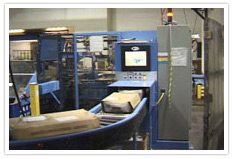
ATR developed the first Automatic Tray Unsleever (ATU) for the USPS and have deployed several systems for field evaluation where they have demonstrated production rates of over 9,000 trays per day!
The ATU is a self-contained machine that can process and unsleeve standard MM, EMM and SMM mail trays at a rate exceeding 15 trays per minute. Incoming trays are scanned to determine tray type and their sleeved or unsleeved status. Once a sleeved tray is inducted, the ATU cuts and removes the strap, removes the tray from the sleeve, and sorts the empty sleeve into a container designated for that type sleeve. The machine separates the straps into a container for recycling. ATR provides a smart facility interface, which allows facility control to monitor operations and control machine functions. This interface complies with the MMS USPS Interoperability Specification.
Automatic Tray Unsleever integrated with a Low-Cost Sorter
TOP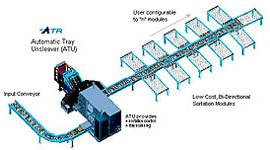
The Automatic Tray Unsleever (ATU) can be used in a variety of configurations. It may be installed as a stand-alone machine, integrated with a simple conveyor as an in-line process, or combined with the next generation Low-Cost Sorter to provide a complete opening unit solution. In this application the incoming mail trays are unloaded onto the input conveyor where they are scanned and unsleeved by the ATU. Then unsleeved mail trays can be inducted onto the main spine of a Low-Cost-Sorter where they are transported and discharged in accordance with the pre-programmed sort scheme. The smart interface of the ATU supports a simple and general interface with the Low-cost Sorter to provide upstream control of the un-sleeving process. This interface will provide for a simple "plug and play" interface to the variety of Low-cost Sorter manufacturers.
Automatic Flats Tub Lidder, Un-Lidder, and Lidder/Un-lidder
TOP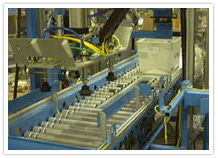
ATR has designed, developed, and fielded automated machinery to both lid and un-lid USPS flats mail trays in the production environment. Depending on site requirements, lidding and un-lidding can be performed by individual dedicated machines, or both of these functions can be combined in a single machine. In either case the process is the same.
In the lidding mode, sensors determine the type of tub and the appropriate lid is selected from either of two rolling cartridge positions. The lid is inserted into the tub, seated into position, and strapped securely in place. In the un-lidding mode, the type of tub is determined, and then the strapping material is cut, removed and discarded. Then the lid is removed and stacked into a cartridge, which can be removed from the machine and rolled to another location.

ATR has developed a specialized device to automatically cancel out of date routing barcode labels on USPS mail tray sleeves, which are being re-used. The machine is portable and rolls easily for convenient positioning next to a conveyor.
In operation, an optical system in the head scans the tops of the trays and "looks" for barcode information. If a barcode is found, one of several airbrush spray heads is activated to line out the barcode rendering it unreadable. This machine eliminates manual tag cancellation and provides automated assurance to prevent misrouting of mail pieces due to expired shipping labels.
Compact Assignment Machine "CAM" - An ACCU-Sort Systems Product
TOP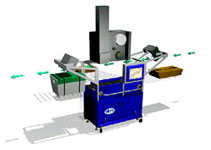
In partnership with ACCU-Sort systems, ATR developed the Compact Assignment Machine (CAM). This machine is designed to require the minimum floor space with a reduced processing rate of 12 trays/minute.
The CAM AAA system can be used as a standalone machine which can be wheeled into position to provide full AAA functionality wherever it is needed. The same machine can also be installed in a conveyor line as a permanent piece of processing machinery.
Two ACCU-Sort "Mini-X" scanners interrogate the front, top, and back of mail trays/tubs to identify the intended destination and search for pre-existing labels. The tray/tub is weighed and the transportation assignments are made based on an information exchanged with the USPS STARSHIP. Mail trays/tubs are labeled, the new label is verified, and the mail tray/tub leaves the system with its transportation and routing assigned through destination.
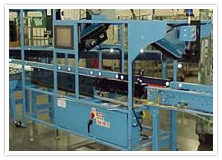
In partnership with ACCU-Sort System, ATR developed the "High Flow" Automatic Airline Assignment (AAA) system. This machine is designed to deliver the highest tray processing rate with a minimal floor space requirement. The "High Flow" AAA is only 90 inches long and can process USPS mail trays at rates exceeding 18 trays/minute.
This machine utilizes the same standardized AAA components and integrates them in a single one-piece frame. This greatly simplifies installation and improves overall reliability with all components held in precise orientation with each other.
The "High Flow" AAA machine has an updated software package that is fully MMS/IOS compliant and supports all the latest USPS label and TAG formats. To date 5 systems have been ordered by the USPS and 3 systems have already successfully passed USPS in-plant acceptance testing in Tererboro P&DC. Click here for Autocad Layout Drawing
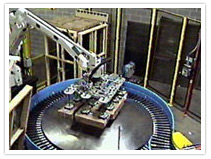
ATR has supplied the USPS with automated robotic unloader systems for palletized USPS mail trays. These machines handle all of the standard mail trays (MM, EMM, SMM) and provide a high volume output of singulated mail trays without the damage typical of "dumpers".
The robotic un-loader cells are high production machines capable of output mail tray streams in excess of 40 trays per minute.
In operation, full pallets are delivered to the cell by forklift, placed in the loading bin, and the shrink-wrap is removed. Active mechanisms straighten the pallet load for robotic unloading. Full pallet layers are unloaded one at a time using a specialized end of arm tool fitted to a high capacity industrial robot. Successive layers of trays are de-scrambled and singulated for induction onto an automated tray line. Two separate pallet loading positions are provided to enable continuous operations so a new pallet can be loaded while the previous pallet is being completed. This unload system can be used for a variety of parcel objects and loading profiles.
Simple Conveyor Sorting Systems
TOP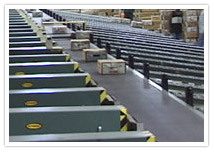
ATR has designed and installed simple conveyor based sorting systems for commercial mailers and fulfillment houses. Typically, these systems use commercial off-the-shelf components and control system software. For these systems ATR provides the overall system design, prepares the system specification and acts as the general contractor to manage vendors, subcontractors and complete the system installation. This provides the customer with a single point of contact for engineering responsibility and job management.
Multiple Tray Loading Cell
TOP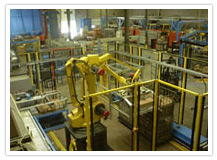
ATR has designed and built a high volume tray-loading cell for airmail facilities where rolling stock is presented automatically and indexed through the loading pen. USPS mail trays are input by powered roller conveyor and staged according to size. Full layers are assembled and staged while the robot is completing the previous load. The Robot End of Arm Tooling (EOAT) is an active device, which carries an entire load layer at one time. The robot positions the EOAT to pick up the assembled layer and move it to the waiting rolling stock where it is inserted one layer at a time.
In-Line Video Image Lift System
TOP
ATR has developed and implemented custom "video-lift" systems integrated in powered roller conveyor beds. Camera and strobe units underneath the conveyor bed, capture tray label information and provide images to remote operator terminals.
Operators resolve hand written labels and assign ZIP codes. ZIP code information is sent to the conveyor control computer and matched with the corresponding parcel as it is tracked through the system and sort decisions are made based on this association.
Underside Scanning Conveyor
TOP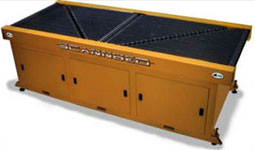
ATR has patented an underside scanning technology and incorporated it into the Scannbed. The Scannbed can be used in simple two-sided scanning application for flat products such as CD's, books, flat-packs, etc., or it can produce a full six-sided scanning solution (as shown below). With the addition of overhead scanners, the Scannbed can provide a very cost effective solution for data collection from randomly oriented packages.
Six Side Scanning Tunnel
TOP
ATR has designed and implemented scanning tunnels, which provide six-sided scan capabilities. These tunnels use conventional barcode scanning technology to read barcodes on any side of a parcel including the bottom. This tunnel solution does not require special illumination and can effectively resolve barcodes at conveying speeds in excess of 600 feet per minute with parcel separation less than .5 meters apart. With this technology, automated induction systems have been demonstrated at rates exceeding 10,000 packages per hour with read rates exceeding 99% for barcode acquisition.
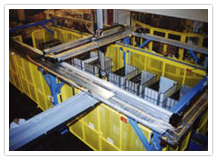
ATR designed, built and fielded the first robotic tray loading systems in the United States Postal Service. These machines were developed in response to raising labor costs and escalating injury rates experienced by workers sorting and loading mail trays into rolling stock containers and standard pallets. Under an extremely short schedule, ATR identified the labor applications with a cost effective return on investment (ROI) and developed two separate systems using standard pedestal and gantry industrial style robots.
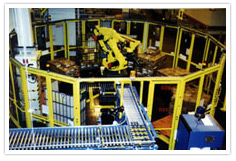
ATR designed a new pedestal robot work cell configuration, integrated the commercial robot, developed all necessary controls, prepared the user interface, and performed the initial field installations. ATR successfully obtained Underwriters Laboratory (UL) certifications. Both pedestal and gantry style cells have exceeded their performance and ROI expectations and prompted the USPS to procure an additional 200 units. This is the largest robot procurement outside the automotive industry and was a first in the material handling business.

ATR designed, built, and developed the software application for an advanced Stamp Distribution System designed for the USPS. The hardware design and software controls address the high security requirements of this operation and tremendously increased worker throughput and efficiencies. ATR designed and built special picker stations where the operators access is automatically restricted to the proper product selection. The control system sequences the individual order containers, or "totes" in such an order that the picker only loads one type of product at a time. This greatly improves speed and maintains overall security with discrete product access. The ATR conveyor system recirculates the totes and stages them for the next sequence of like products. The system tracks the totes as they move between nested levels of recirculation loops between "picker" stations and final dispatch for shipping. Finished orders exit the system when they are individually completed. The overall control is PC based and provides a rich set of graphical interfaces where operators interact with selected products based on p ictures of the stamps.
System Controllers
TOP
ATR is an industry leader in the development of sophisticated control systems for material handling, robotics and industrial automation. ATR follows a non-proprietary, open systems approach that allows for rapid development, testing and deployment of specialized control systems. Since it is an open systems approach based on national and industry standards, the system is easily extended and maintained. ATR has extensive experience in all areas of control systems design and development, from high-level supervisory control and diagnostics to the demanding real-time requirements of motion control for robotics and machine tool applications. The system architecture seamlessly combines these different levels of control to shorten development time and improve system reliability. ATR uses industry-standard software tools to aid in long-term maintainability and flexibility. Controls applications are developed in Microsoft's Visual C++, a widely supported object-oriented software development environment. Windows NT provides a widely accepted system platform that is suitable for both controls and graphical user interface applications.
Custom Robotic Tooling
TOP
ATR has developed a variety of custom end-of-arm tooling (EOAT) which have been key to the effectiveness of several robotic material handling applications. Of particular interest, has been the compliant tooling needed to accommodate the wide variety of packages and handle them reliably in spite of their dimensional variety, and the full range in dimensional reliability and surface quality. These EOAT designs have often been the key to making a robotic application a viable processing alternative.
Robotic Pallet to Pallet Tray Sortation System
TOP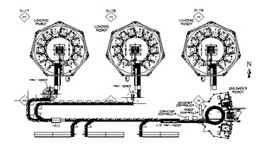
ATR designed and integrated a pallet-to-pallet automated tray sorting solution for the USPS Kansas City bulk mail facility. This system uses a robot to unload pallets full of mail, singulate and sort the mail to one of three robotic tray loading cells or manual run outs. Full operator utilities are provided for system status and sort scheme maintenance. This system provides production level loading and loading with minimal manual support.
Mail Consolidation Center (MCC)
TOP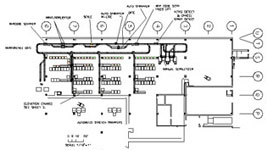
Representative of ATR's complex systems capabilities, ATR designed and implemented an automatic mail tray preparation and sortation system based upon Powered roller conveyor and a PC/Windows NT based control system. The MCC system processed mail trays at a rate of 14,000 trays per tour and at a tray rate of 30 trays per minute. Trays were inducted into the system, selectively processed and then sorted and transported to one of 13 different run-outs using a system of bar code scanners, powered roller conveyor, multiple diverters, and 90 degree transfers operating under computer control with a "point and click" user interface.
Return Merchandise System
TOP
ATR has designed a Return Merchandise System for a USPS pilot project to expedite the returns processing for postage due. This system is highly automated and only requires human intervention when packages are oversized or unreadable. Bulk loads of parcels are induced from dumpers to a singulation system then through a 6-sided scanning tunnel where label information is read. If successful the parcel is transported to the automated induction line where it is weighed, dimensioned, and billing information resolved. Unreadable parcels are passed to manual lines where operators weigh and dimension the parcels manually. Once resolved the parcels are inducted onto a sorter and separated by destination for shipping.
USPS Mail Processing Simulation
TOP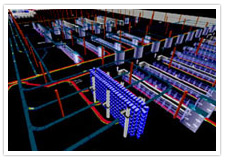
ATR engineers develop complex system designs and evaluate their performance with high fidelity simulations. Overall system performance and throughput can be evaluated under a full range of "what-if" scenarios to discover design sensitivities and optimize the many aspects of sizing, speed and capacities. Active simulations can include full "fly through" visualizations to effectively communicate complex layouts and manpower utilizations. ATR is experienced in the development of Return on Investment (ROI) calculations for automated processes and utilizes simulation for validation.
Process Simulation and Analysis
TOP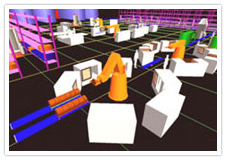
ATR engineers develop robotic work cell designs and can similarly evaluate their performance with high fidelity simulation. Overall system performance, throughput, and ROI can be evaluated and effectively communicated to others.
ATR has experience in a wide range of robotic work cell designs and field implementation included the certification process required for Underwriters Laboratory UL field certification process.

